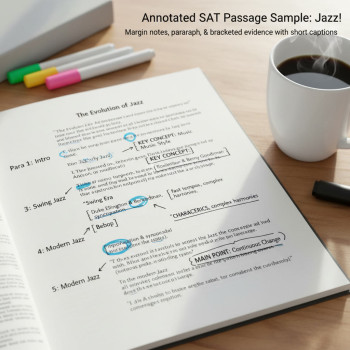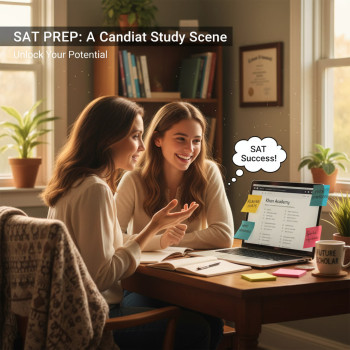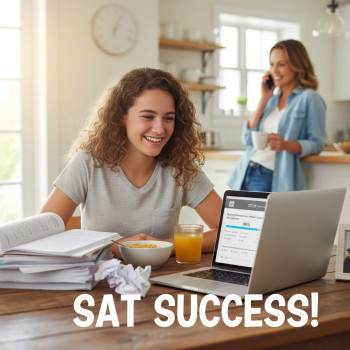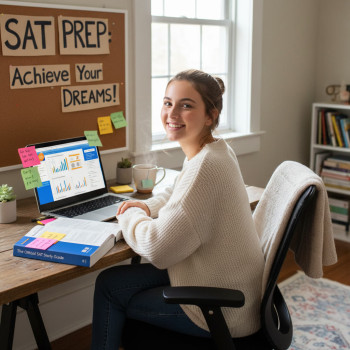Why Talking About SAT Scores and Scholarships Matters
There’s a special kind of nervous energy that comes the day SAT scores arrive. For some families it’s excitement—proof that long evenings of practice paid off. For others it’s uncertainty: how do you talk about a number that feels like it could define the next four years?
Here’s the truth: SAT scores are one useful piece of a much bigger story. They matter to colleges and to many scholarship committees, but how you frame those scores—what you emphasize in conversations and applications—often matters just as much. This post gives you ready-to-use scripts, context, and small strategies that turn awkward, high-stakes talks into productive, confidence-building conversations.

Before the Conversation: Preparation Tips
Good conversations start with a little preparation. Before you talk with a counselor, coach, or family member about SATs and scholarships, take these steps:
- Know the numbers: your total score, section scores (Reading & Writing, Math), and percentiles. For Digital SAT test-takers, also be aware of the report features that show strengths in specific content areas.
- Set goals: decide whether you want to aim for score improvement, search scholarships now, or prioritize other parts of the application (grades, essays, activities).
- Gather evidence: recent grades, AP scores, extracurricular highlights, and teacher recommendations that complement or contextualize your score.
- Plan the ask: if you hope to request more test preparation help or to appeal for financial support, be clear about what you’re asking for and why.
How Colleges and Scholarships Use SAT Scores (Plainspoken)
Colleges set their own rules. Some use SAT scores to admit students, some use them for placement or course guidance, and others consider them for scholarship decisions. Scholarship programs vary even more—some have strict cutoffs, others look for leadership, need, or niche eligibility. Knowing the difference helps you frame your conversations.
Two practical things to remember:
- Test-optional doesn’t mean test-irrelevant. If your score strengthens your application, send it. If not, focus on other areas.
- Scholarship committees often look beyond a single score—grades, essays, activities, and demonstrated interest or need are part of the equation.
Script Bank: Short Conversations for Immediate Use
Below are concise scripts you can use in real conversations—at home, with counselors, or when emailing scholarship offices. Read them aloud, tweak the details, and make them yours.
Script A — Telling a Parent (calm, confident)
“I got my Digital SAT scores back today. My total is [score], with [RW score] in Reading & Writing and [Math score] in Math. I’m proud of the improvement I made in [area], and I see some clear steps to raise my Math by [X] points if I focus on [topic area]. Can we plan a week of practice together and look at scholarship options I qualify for?”
Script B — Emailing a College Counselor (clear, action-oriented)
“Hello [Counselor Name], I wanted to share my Digital SAT results: total [score]. I’m aiming to improve to [target score] before applications. Could we review my practice plan and scholarship prospects? I’d appreciate any advice on merit-based scholarships linked to SAT ranges at our colleges of interest.”
Script C — Asking a Scholarship Committee (polite, persuasive)
“Dear Scholarship Committee, I’m applying for [award]. My SAT total is [score]. Beyond test scores, I lead [activity], maintain a [GPA] GPA, and volunteer with [organization]. I hope you’ll consider my academic and community record in addition to my test performance as you review my application.”
Script D — Requesting Support From a Teacher or Mentor (respectful, specific)
“Hi [Teacher], I scored [score] on the Digital SAT and want to boost my math section. Could we review a couple of practice sections together? I could use feedback on timing and problem strategies—one session a week would be incredibly helpful.”
Script E — When the Score Is Lower Than Expected (honest, forward-looking)
“I didn’t hit my target this time—my score is [score]. I’m disappointed, but I’ve identified the areas I’ll prioritize. I’d like to set up a study schedule and possibly use tailored tutoring to improve. Can we talk about next steps?”
Longer Conversations: Role-Playing Scenarios
Sometimes a deeper, face-to-face conversation is needed—especially when scholarships or financial aid are on the line. Here are two role-play templates you can adapt.
Scenario 1: Student and Parent Discussing Scholarship Strategy
Use this template for a 20–30 minute planning session. Assign roles and run through it like a mini-meeting.
- Opening (2 minutes): Student: “Thanks for making time. I want to talk about how my SAT score affects scholarships and what we can do next.”
- Review (5 minutes): Student shares score and context—PSAT performance, coursework, and activities.
- Options (10 minutes): Explore whether to retake the SAT, what scholarships align with current scores, and how to strengthen other application elements.
- Decisions & Actions (5–10 minutes): Agree on 2–3 concrete steps—practice hours per week, contacting a counselor, applying to Student Search Service, or booking a session with a tutor.
Scenario 2: Student Meets Financial Aid Office
When you meet with a financial aid officer, preparation and tone matter. Bring documents, be concise, and show how your whole profile supports the ask.
- Introduce yourself and state intent: “I’m interested in merit scholarships and want to understand how my Digital SAT score of [score] fits into eligibility.”
- Share the whole picture: GPA, leadership roles, and special circumstances (e.g., first-generation, family need).
- Ask specific questions: “Are there scholarships with explicit score ranges? Can I submit additional materials that show my potential?”
- Follow up: “May I send updated scores or additional recommendations if they help my application?”
Scripts for Different Outcomes: Send, Skip, or Supplement?
Deciding whether to send an SAT score to a college or scholarship program can feel like choosing a path between two important options. Here are scripts for each choice.
Send the Score (when the score strengthens your application)
“We’ll send my Digital SAT score of [score] to [College]. It highlights my strengths in [section] and supports applications for merit scholarships tied to SAT ranges.”
Skip the Score (when you’re better off withholding)
“I’m not sending this score because my recent grades, recommendations, and essays present a stronger picture. I’ll focus on applying test-optional and highlighting my other achievements.”
Supplement the Score (send plus more context)
“I’m sending the score but also attaching an academic update: my current GPA, a note about improved coursework, and a short statement explaining how I’ve strengthened my math skills since testing.”
How to Talk About the Digital SAT Specifically
The SAT went digital in recent years, and the reporting now includes helpful breakdowns—content-area strengths, percentiles, and clearer visualizations. Use that to your advantage in conversations:
- Mention specific content strengths shown in the digital report. Example: “The report shows I excel in algebraic problem solving but need work with data interpretation.”
- Use percentile context: “I’m in the [X]th percentile nationally—here’s how that compares to our state averages.”
- Point out practice resources: free official practice and school-based supports that show a pathway to improvement.
Real-World Examples: Scripts with Specific Details
Here are a few filled-in examples you can adapt to your situation.
Example 1: Aiming for Merit Aid
“Hi Admissions Team—my name is Maya Rodriguez and I’m applying for the Class of [year]. My Digital SAT total is 1370 (RW 700, Math 670). I’m a candidate for merit aid and would love to know if that score aligns with typical scholarship ranges. My transcript includes a 3.9 GPA, AP Calculus AB (5), and leadership as Student Council President.”
Example 2: Explaining a Low Score with Upward Trajectory
“Dear Scholarship Committee—I scored 1110 on the Digital SAT, which doesn’t fully reflect my recent academic growth. Since then, I’ve raised my GPA from 3.2 to 3.8 and earned a 5 on AP English Language. I’m happy to supply an academic update and a teacher letter speaking to my progress.”
Conversation Do’s and Don’ts
Keep these simple rules in mind to keep dialogues productive and respectful.
- Do use specific numbers and examples. Vague phrases like “I did better” won’t help scholarship committees or counselors assess prospects.
- Do be honest about gaps and next steps. A mature plan to improve shows initiative.
- Don’t dwell on blame—focus on solutions rather than fault.
- Don’t let a single test define a candidacy—highlight strengths elsewhere if needed.
Tools to Make These Conversations Easier
There are practical tools that streamline outreach and scholarship matching. For instance, the Student Search Service connects students to colleges and scholarships based on basic profile information. BigFuture’s scholarship search helps uncover thousands of opportunities. And for many students, a combination of smart practice and tailored support—like Sparkl’s personalized tutoring with 1-on-1 guidance, tailored study plans, expert tutors, and AI-driven insights—can accelerate progress and make conversations with colleges more confident.

Sample Email Templates You Can Copy and Edit
Below are polished email templates for common situations. Personalize the bracketed items and keep the tone respectful and concise.
Email 1 — Requesting Merit Scholarship Information
Subject: Merit Scholarship Eligibility Inquiry — [Student Name]
Dear [Financial Aid Office],
My name is [Student Name], and I am applying for admission for Fall [year]. My Digital SAT total is [score], with section scores of [RW] and [Math]. I am particularly interested in merit scholarship opportunities and would like to know whether my current score fits within your typical award ranges. I can provide additional academic updates and recommendations upon request.
Thank you for your time—
[Student Name]Email 2 — Asking for a Score Review or Consideration
Subject: Additional Materials for Scholarship Review — [Student Name]
Dear [Scholarship Committee],
I’m writing to submit additional context for my application. My Digital SAT score is [score], but since testing I have completed [relevant coursework or achievement], raising my GPA to [GPA]. I’d be grateful if you’d accept an academic update or an extra letter of recommendation that speaks to my recent progress.
Warm regards,
[Student Name]Data at a Glance: How Scores Often Map to Scholarship Tiers
Below is a simplified table illustrating how some merit-based scholarship tiers correlate with SAT ranges. This is a general framework—actual award criteria vary by institution. Use it as a conversation starter rather than a rulebook.
| Typical Scholarship Tier | Common SAT Range | What To Emphasize |
|---|---|---|
| Top merit awards | 1450–1600 | High-level leadership, research, or national recognition; strong AP/IB results |
| Strong merit scholarships | 1300–1440 | Solid GPA, extracurricular leadership, targeted essays |
| Moderate scholarships | 1150–1290 | Consistent academic performance, community service, local awards |
| Need-based or program-specific awards | Variable | Financial need, special talents, major-specific achievements |
When to Retake the Digital SAT—and How to Explain It
Retaking the SAT makes sense if you can reasonably expect improvement with focused study. If your score is near a scholarship cutoff or below a school’s typical range, a retake may be worth it. Be prepared to explain the difference between tests—avoid sounding defensive.
Script for explaining a retake: “I’m planning to retake the Digital SAT because my practice consistently shows I can add [X] points with targeted study in [topic]. I want to submit the best possible application and be competitive for merit scholarships.”
How to Use Non-Test Strengths When Scores Don’t Tell the Whole Story
If your score isn’t as high as you hoped, remember that admissions and scholarship readers value context. Use essays, recommendation letters, and activity lists to highlight growth, resilience, creativity, and leadership.
- Write a short academic update if your grades improved after testing.
- Ask mentors to emphasize specific strengths that the score doesn’t capture.
- Use the scholarship essay to narrate a compelling story—impact matters.
Practical Checklist for a Scholarship Conversation
Before you call or meet, run through this quick checklist:
- Current Digital SAT total and section scores.
- GPA and recent academic trends.
- List of relevant extracurriculars and leadership roles.
- Clear, realistic target (retake date or scholarship deadline).
- One-sentence ask: what you want from the person you’re speaking to.
Making a Plan: A 6-Week Action Roadmap
Here’s a compact plan to use when you decide to pursue scholarship opportunities aggressively.
- Week 1: Collect scores, join Student Search Service, and update BigFuture profile. Map target scholarships and deadlines.
- Week 2: Create a study schedule. If you need tailored support, consider 1-on-1 tutoring—Sparkl’s personalized tutoring can create a focused plan and accelerate weak-area gains.
- Week 3: Draft scholarship essays; request recommendation letters.
- Week 4: Take at least two full-length digital practice tests under timed conditions; analyze mistakes.
- Week 5: Finalize essays and application materials; continue targeted practice.
- Week 6: Submit applications, send scores where beneficial, and follow up politely with scholarship offices if allowed.
Final Words: Keep Conversations Constructive and Future-Focused
Talking about SAT scores and scholarships doesn’t have to be stressful. With clear facts, a calm plan, and a few well-crafted scripts, you can turn score day into strategy day. Remember that scores are a tool—one part of your narrative. If improvement is the goal, use data from your digital score report to make concrete plans. If scholarships are the prize, pair your SAT context with strong essays, recommendations, and demonstrated interests.
And if extra help would make the difference, remember that personalized support—like one-on-one tutoring, tailored study plans, expert tutors, and AI-driven insights—can be a practical investment rather than an abstract hope. The right guidance helps you tell your story more clearly, hit target scores, and win the conversations that matter.
Now: pick one script above, personalize it, and start a conversation today. A short, thoughtful talk can open doors to scholarships, better college matches, and a more confident application season.
















No Comments
Leave a comment Cancel